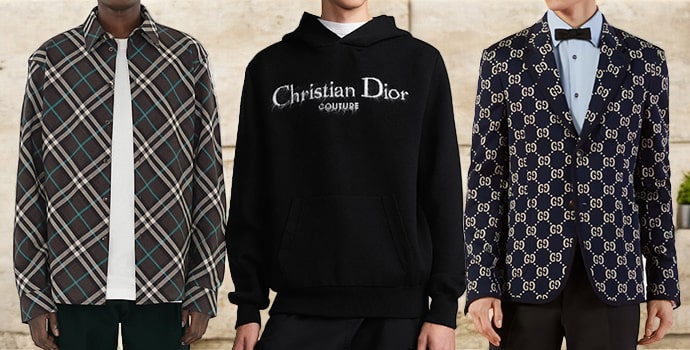How Branded Clothing Uses Fabric to Match Season and Occasion
How Branded Clothing Uses Fabric to Match Season and Occasion
Blog Article
Understanding Garments: The Importance of Textile Selections in Your Closet
The selection of textile in garments plays a pivotal duty in both aesthetics and capability. Various products provide differing degrees of breathability, longevity, and comfort, straight influencing the user's experience. Comprehending these subtleties can boost one's wardrobe noticeably. Several neglect how these selections can affect not simply personal design, but additionally sustainability. What fabric choices could redefine your closet and straighten it with both style and obligation?
The Duty of Textile in Style and Capability

Common Fabric Types and Their Features
When picking apparel, understanding the characteristics of typical textile types is crucial for making educated selections. Cotton, a widely-used natural fiber, is recognized for its breathability, soft qualities, and convenience, making it appropriate for sportswear and day-to-day garments. Bed linen, one more all-natural choice, boasts superb moisture-wicking buildings and an unique appearance, perfect for cozy climates.Wool, often preferred for its heat and longevity, differs in fineness; merino wool is soft versus the skin, while coarser types are utilized for outerwear. Synthetic textiles like polyester and nylon supply resilience and resistance to creases, making them popular for activewear and traveling garments. Lastly, blends, which integrate synthetic and natural fibers, can enhance functionality while preserving comfort. By acknowledging these material attributes, individuals can select apparel that lines up with their way of life and visual choices.
Breathability and Convenience: Choosing the Right Fabrics for Different Climates
Selecting the right materials for different environments can considerably improve convenience and total wearability. Breathable materials are vital in hot environments, as they permit air blood circulation and moisture dissipation. Fabrics such as cotton, bed linen, and moisture-wicking synthetics properly attract sweat far from the body, maintaining the wearer cool and completely dry. On the other hand, in colder climates, thicker fabrics like woollen or fleece give insulation while preserving breathability, guaranteeing heat without overheating.Additionally, the selection of fabric weight plays an essential role; lightweight materials are more effective for summertime, whereas larger choices are fit for winter months wear. Recognizing the special homes of each material allows people to clothe suitably for varying weather conditions. Ultimately, choosing breathable and comfortable materials customized to particular climates can substantially enhance daily comfort and enhance the general experience of wearing clothes.
Durability and Treatment: Exactly How Fabric Influences Durability of Your Closet
Selecting the right products can greatly influence the longevity and care demands of a closet. Fabrics such as cotton and polyester are understood for their strength and convenience of maintenance, making them optimal for day-to-day wear. On the other hand, fragile materials like silk and shoelace require more cautious handling and specialized cleansing approaches, which can raise the time and initiative required for care. Branded Clothing.Durability is additionally influenced by the textile's weave and surface; snugly woven textiles often tend to withstand damage far better than loosely woven alternatives. Furthermore, artificial blends often provide enhanced toughness, incorporating the very best high qualities of multiple fibers.Understanding the care instructions for each and every material is necessary, as inappropriate drying out or cleaning can lead to early wear. Ultimately, selecting durable products can bring about a longer-lasting closet, lowering the frequency of replacements and adding to an extra lasting style option
The Impact of Material on Fit and Silhouette

Lasting Textile Choices: Making Eco-Friendly Choices
The influence of textile prolongs beyond fit and silhouette to incorporate environmental elements, motivating a growing rate of interest in lasting textile choices. Eco-friendly fabrics, such as organic cotton, hemp, and Tencel, are obtaining traction amongst consumers who focus on sustainability in their closets. These products are frequently generated with fewer chemicals and water, lowering their ecological footprint.Additionally, recycled textiles, made from post-consumer waste, supply an ingenious solution to the textile industry's pollution issue. Brands progressively embrace transparency in their sourcing methods, allowing consumers to make educated choices about their purchases.Choosing lasting materials not just supports honest practices yet also encourages the garment industry to embrace more accountable production approaches. As recognition of environmental concerns increases, people are advised to mirror on the long-term impact of their material options, promoting an activity towards my company a more sustainable and eco aware approach to fashion.
Elevating Design: Just How Textile Can Transform a Clothing
While many may focus on shade and cut when picking an outfit, the choice of textile plays a crucial function in elevating design and enhancing overall look. Different products share unique state of minds and messages; for instance, silk exhibits deluxe and class, while denim uses a casual, kicked back vibe. The structure and drape of a material can drastically modify the silhouette, with structured textiles supplying a polished appearance and softer ones developing an extra fluid, unwinded aesthetic.Moreover, the weight of the fabric affects wearability throughout seasons. Light-weight textiles like bed linen and cotton are optimal for summer, while larger products such as woollen and velvet offer warmth and beauty in chillier months. Comprehending textile properties, such as breathability and stretch, also encourages people to make educated options that improve convenience without jeopardizing style. Ultimately, the right material can transform an attire from regular to amazing, making it a vital consideration in any wardrobe.
Frequently Asked Questions
How Do I Identify the Textile Web Content of My Apparel?
To recognize textile material, one can examine treatment labels, conduct burn examinations for fiber recognition, or speak with material swatches. These techniques aid differentiate products, guaranteeing notified choices for clothing treatment and maintenance in day-to-day wear.
Can Material Choice Affect My State Of Mind or Self-confidence?
Textile choice can substantially affect a person's state of mind and confidence. Branded Clothing. Specific products may evoke sensations of comfort or sophistication, while others can really feel limiting or unflattering, eventually affecting self-perception and psychological well-being throughout the day
What Fabrics Are Finest for Sensitive Skin?
For people with sensitive skin, natural materials like bed linen, cotton, and bamboo are frequently suggested. These products are breathable, hypoallergenic, and less most likely to create inflammation, making them ideal options for comfort and skin wellness.
Exactly how Do I Properly Wash and Look After Different Fabrics?
To effectively clean and care for different fabrics, one should consider each product's certain requirements, consisting of temperature level settings, cleaning agents, and drying techniques, guaranteeing long life and keeping the material's initial qualities for optimal usage.
Exist Certain Fabrics for Athletic or Efficiency Put On?
Sports or efficiency wear frequently utilizes materials such as spandex, nylon, and polyester. These materials are created for moisture-wicking, breathability, and versatility, improving activity and comfort during exercises while supplying sturdiness and support. Alternatively, in cooler environments, thicker materials like wool or fleece provide insulation while preserving breathability, making sure heat without overheating.Additionally, the option of material weight plays a vital duty; lightweight textiles are better for summer season, her response whereas heavier options are suited for winter link months wear. In comparison, delicate products like silk and lace require even more mindful handling and specialized cleaning approaches, which can increase the time and effort required for care.Durability is also influenced by the material's weave and coating; snugly woven materials have a tendency to resist wear and tear far better than loosely woven alternatives. In comparison, inflexible textiles can limit activity but give a traditional, refined look.Moreover, the density and appearance of the material can influence the aesthetic perception of body shape. The effect of fabric expands beyond fit and shape to incorporate environmental variables, motivating a growing passion in sustainable fabric selections. The structure and drape of a fabric can considerably modify the silhouette, with organized materials supplying a refined appearance and softer ones producing a much more fluid, loosened up aesthetic.Moreover, the weight of the fabric influences wearability across periods.
Report this page